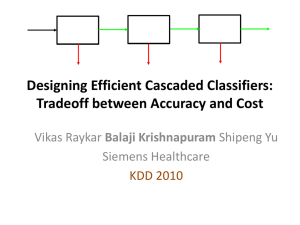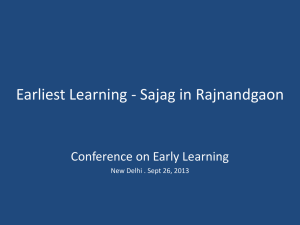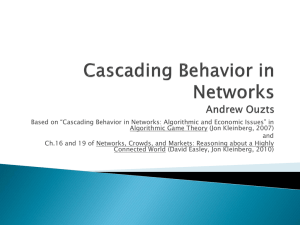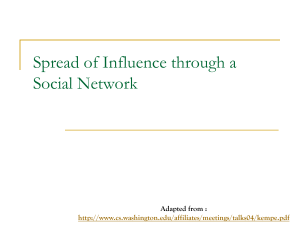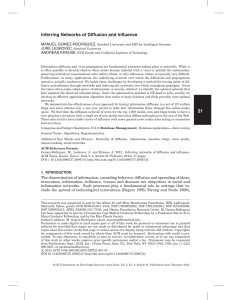Inferring Networks of Diffusion and Influence
advertisement
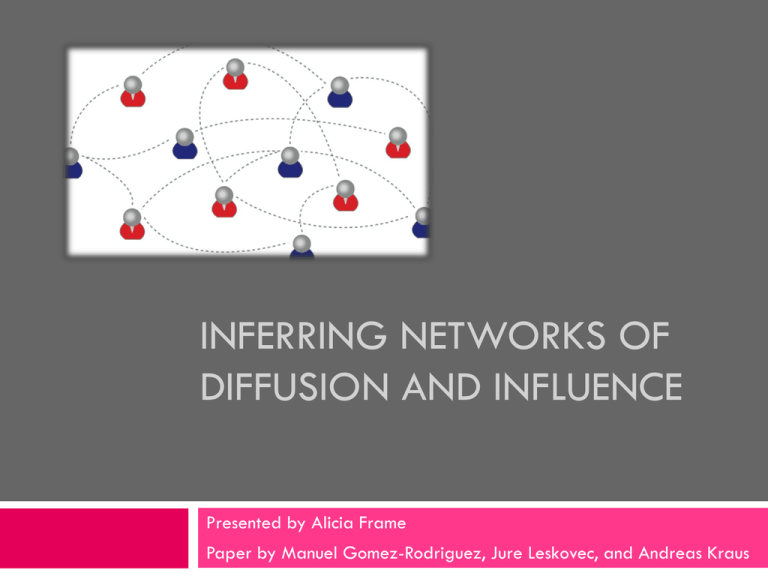
INFERRING NETWORKS OF DIFFUSION AND INFLUENCE Presented by Alicia Frame Paper by Manuel Gomez-Rodriguez, Jure Leskovec, and Andreas Kraus Introduction Network diffusion is an important process – information spread, epidemiology Challenges: To track cascading processes, you need to identify the contagion and how to trace it Diffusion takes place on a network but this network is usually unknown and unidentified Know when a node is infected, but not by whom Introduction Questions: 1. 2. 3. What is the network over which information propagates What is the global structure of the network? How do news media and blogs interact Problem Formulation Assumptions: Many different cascades propagate over an unknown static network Observe when nodes get infected, but not by whom Goal: Infer the unknown network over which cascades propagate Infer the network where a directed edge (u,v) means that node v tends to be infected after node u Example Network is made up of news sites and blogs on the web Each cascade is a different piece of information spreading through the network Know when a piece of information was mentioned on a site And edge (u,v) means that a site v tends to repeat stories after a site u Problem Statement Given a hidden network G*, observe multiple cascades to get an estimated version of the network, Each cascade leaves a trace (ui, ti, φi)c Cascade c reached node ui at time ti with a set of attributes φi If a node is not hit by a cascade then tu=∞ A cascade is fully specified by Vector t=[t1, . . . , tn] of hit times Feature vector φ=[φ1, . . ., φn] describing the properties of the contagion and the node Model Formulation Assumptions: For a fixed cascade c=(t, φ), we know which nodes influenced other nodes Every node v in a cascade is influence by at most one node u Each cascade is given by a directed tree, T, which is contained in G Probabilistic model: Cascade Transmission Model Cascade Propagation Model Network Inference Model NetInf algorithm Cascade Transmission Model How likely is it the a node u spreads the cascade c to a node v A node infects each of its neighbors independently Ignore multiple infections because the first is sufficient Pc(u,v) is the conditional probability of observing cascade c spreading Cascades only propagate forward in time if tu>tv, Pc(u,v)=0 Probability of transmission depends only on the time difference between node hit times: Cascade Transmission Model Need to determine the time, tv, when u spreads the cascade to v Probability (1-β) that the cascade stops before v and tv= ∞ Otherwise, tv= tu + Δ Consider power law and exponential models of waiting time Given the probability Pc(u,v) , you can define the probability of observing cascade c propagating in a particular tree structure T Cascade Propagation Model We know the probability of a single cascade c propagating in a particular tree T – P(c|T) Need to compute P(c|G), the probability that a cascade c occurs in a graph G Combine the probabilities of individual trees into a probability of a cascade c occurring over a graph G Consider all the ways c could have spread of G Define the probability of a set of cascades, C, occurring in G Network Inference Problem Aim is to find the most likely graph, the observed cascades , that describes Computing the probability of each cascade, and then the probability of each tree, is intractable Super exponential in the size of G Can be improved to O(|C|n3), but that is still too expensive Above formulation only evaluates the quality of a particular graph G, whereas we want the best graph Proposed Algorithm Instead of considering every possible tree T, only consider the most likely propagation tree, T Define the improved of a cascade c under a graph G over an empty graph: The maximum of P(C|G) =FC(G) Proposed Algorithm Introduce an additional node m, an external source that can infect any node u Connect m to all nodes in the graph with an ε edge Most likely tree T is a maximum weighted spanning tree in G Each edge (i,j) has weight wc(i,j) and Fc(G) is the sum of the weighted edges in T Proposed Algorithm Start with an empty graph, K FC is non negative and monotonic Adding more edges does not degrease solution quality The complete graph will maximize FC We are interested inferring sparse graphs which only include a small number k of relevant edges Solving this is NP hard Proposed Algorithm You can prove that FC is submodular diminishing returns property Allows you to find a near optimal solution to the problem Greedy algorithm Start with empty graph Iteratively add the edge ei which maximizes marginal gain Stop once it has slected k edges and return the solution Proposed Algorithm Can be sped up with localized updates and lazy evaluations Evaluation with Synthetic Data Forest fire model: essentially a scale free graph Kronecker Graph: Random graph Hierarchical community structure Core periphery network Simulate cascades parameterized by how quickly the cascade spreads and how far it spreads, picking starting nodes at random Experiments on Synthetic Data Solution quality: how close does the NetInf algorithm get to the optimal solution Experiments on Synthetic Data Accuracy: how many edges inferred by NetInf are present in the true network G* fraction of edges in Gk also in G* Recall: fraction of edges in G* also in Gk Precision: Compared to ‘baseline method’ For each possible edge (u,v) compute how likely were the cascades c ϵ C to propagate from u to v Pick the k edges with the highest weight Experiments on Synthetic Data NetInf performs better than the baseline in 97% of cases Experiments on Synthetic Data: NetInf requires the total number of transmission events between 2 and 5 times the number of edges in G* With lazy evaluation and localized update, computation time is two orders of magnitude faster Experiments on Real Data Over 172 million news articles and blog posts Used hyperlinks between blog posts to retrieve information Also used ‘memetracker’ methodology extracts short textual phrases Cluster baased on different textual variants of the same phrase Cascade is the set of time stamps Considered the top 1,000 media sites with the most documents and the 5,000 largest cascades Experiments on Real Data Largest connected component after 100 edges added Using hyperlinks only Experiments of Real Data Interesting patterns: Clusters of sites related to politics, gossip, and technology Mainstream media sites act as connectors between parts of the network Issues Gawker media owns several of the prominent blogs, which all link to eachother Typos in the nodes result in them showing up multiple times Obscure blogs marked as ‘central’ Experiments on Real Data Also used memetracker to look at global structure of information propagation Most information propagates from mainstream media to blogs Media to media links are the strongest Links capturing influence of blogs onto media are rare Conclusions Novel tractable solution to information propagation on networks with an approximation guarantee Developed a generative model of information cascades Exploiting the submodularity of the objective function, they developed NetInf to infer a near-optimal set of k directed edges Using synthetic data, found NetInf can accurately recover the underlying network Allows study of properties of real world networks Discussion? Only applicable to static networks Requires full knowledge of ‘infection times’ Requires many cascades to accurately infer graph Probably not extensible to their other examples Epidemiology There are already effective techniques for systems biology External node assumption?

